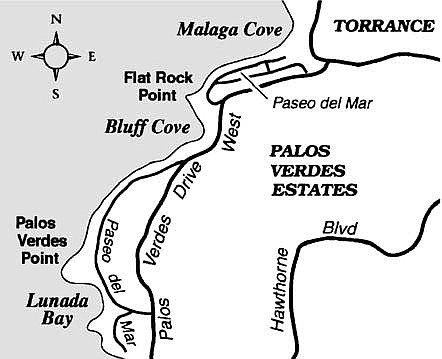 Facebook
Facebook
 X
X
 Instagram
Instagram
 TikTok
TikTok
 Youtube
Youtube
Forged by local uplift of the seafloor roughly two million years ago, today's Palos Verdes peninsula lay surrounded by the ocean for hundreds of thousands of years. Later, the alluvium that covers today's Los Angeles Basin rose above sea level and connected the peninsula to the mainland. In one sense, though, Palos Verdes remains an island today. The peninsula rises above the mind-numbing suburban and industrial sprawl of greater L.A. like an island of serene opulence and scenic beauty.
To get a sense of Palos Verdes' "otherness," try the following rock-hopping expedition along the peninsula's northernmost coastline. With near-vertical cliffs on one side and foamy surf on the other, you'll truly feel as if you're treading the wild edge of the continent.
Wear shoes or boots with good ankle support, and realize that they might get soaked with saltwater. Allow nearly two hours to complete the two-mile journey that takes you south along the coast over wave-rounded boulders and back to the start via city streets. Time your visit so that it coincides with low tide, or better yet extreme low tide. Strongly negative tides are scheduled to occur during the afternoons on the following remaining days this year: Thursday through Sunday, November 11-14; Thursday through Sunday, November 25-28; Friday through Tuesday, December 10-14; and Friday through Monday, December 24-27.
To get to the starting point, Malaga Cove, which is just south of the city of Torrance, turn north on Via Corta from Palos Verdes Drive West. After 0.5 mile, make a right on Via Arroyo. One more right turn, on Paseo del Mar, takes you to a parking area in front of the Malaga Cove Intermediate School.
Find the top of the paved pathway at the far end of Paseo del Mar and walk down to the beach. Turn left along the shoreline and make your way over the obstacle course of wave-pounded rocks. After a short mile you arrive at Flat Rock Point, a popular area for tidepooling when the tide is low. Wide, curving Bluff Cove lies just ahead. From there, take the pathway on the left going back up the cliff to Paseo del Mar. You can then return to your car by strolling the four long blocks of Paseo del Mar leading back to the school. Lining both sides of this street are some of Palos Verdes' most attractively landscaped dwellings -- reminiscent of those in similar neighborhoods in La Jolla.
Practically the entire west-facing coastline of the Palos Verdes peninsula is walkable at low tide. You can proceed south to Lunada Bay and beyond if the spirit moves you.


Forged by local uplift of the seafloor roughly two million years ago, today's Palos Verdes peninsula lay surrounded by the ocean for hundreds of thousands of years. Later, the alluvium that covers today's Los Angeles Basin rose above sea level and connected the peninsula to the mainland. In one sense, though, Palos Verdes remains an island today. The peninsula rises above the mind-numbing suburban and industrial sprawl of greater L.A. like an island of serene opulence and scenic beauty.
To get a sense of Palos Verdes' "otherness," try the following rock-hopping expedition along the peninsula's northernmost coastline. With near-vertical cliffs on one side and foamy surf on the other, you'll truly feel as if you're treading the wild edge of the continent.
Wear shoes or boots with good ankle support, and realize that they might get soaked with saltwater. Allow nearly two hours to complete the two-mile journey that takes you south along the coast over wave-rounded boulders and back to the start via city streets. Time your visit so that it coincides with low tide, or better yet extreme low tide. Strongly negative tides are scheduled to occur during the afternoons on the following remaining days this year: Thursday through Sunday, November 11-14; Thursday through Sunday, November 25-28; Friday through Tuesday, December 10-14; and Friday through Monday, December 24-27.
To get to the starting point, Malaga Cove, which is just south of the city of Torrance, turn north on Via Corta from Palos Verdes Drive West. After 0.5 mile, make a right on Via Arroyo. One more right turn, on Paseo del Mar, takes you to a parking area in front of the Malaga Cove Intermediate School.
Find the top of the paved pathway at the far end of Paseo del Mar and walk down to the beach. Turn left along the shoreline and make your way over the obstacle course of wave-pounded rocks. After a short mile you arrive at Flat Rock Point, a popular area for tidepooling when the tide is low. Wide, curving Bluff Cove lies just ahead. From there, take the pathway on the left going back up the cliff to Paseo del Mar. You can then return to your car by strolling the four long blocks of Paseo del Mar leading back to the school. Lining both sides of this street are some of Palos Verdes' most attractively landscaped dwellings -- reminiscent of those in similar neighborhoods in La Jolla.
Practically the entire west-facing coastline of the Palos Verdes peninsula is walkable at low tide. You can proceed south to Lunada Bay and beyond if the spirit moves you.
